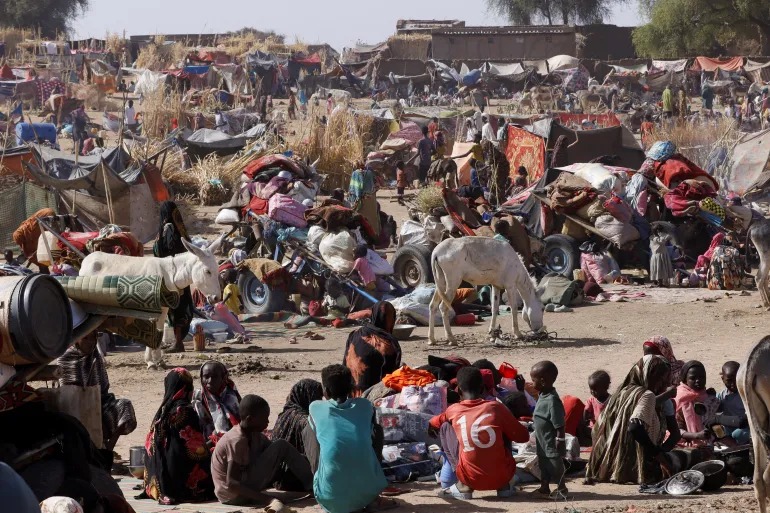
Introduction
The Darfur Crisis has worsened as Sudan’s Rapid Support Forces (RSF) launched targeted attacks on civilians in North Darfur, particularly following the takeovers of El Fasher and Bara. These operations have intensified displacement, causing thousands of residents to flee to temporary shelters and camps. Basic necessities like food, water, and medical aid are in short supply, creating an urgent humanitarian emergency. International organizations face challenges reaching affected populations due to insecurity. The RSF’s actions not only endanger civilians but also threaten regional stability. Addressing the Darfur Crisis requires coordinated efforts from local authorities, humanitarian agencies, and global partners to mitigate the ongoing suffering.
Darfur Crisis — 1) Background and Historical Context
The Darfur Crisis is rooted in longstanding political, ethnic, and social tensions in Sudan. Historically, the region has experienced cycles of armed conflict, marginalization, and displacement. These conditions have made civilians highly vulnerable to violence and economic instability. Understanding this context is crucial for grasping the full impact of RSF attacks and planning effective humanitarian and security interventions. Lessons from past crises also provide insights into prevention and response strategies.
Darfur Crisis — 2) RSF Seizure of Key Cities
The Darfur Crisis escalated significantly after the RSF captured El Fasher and Bara, consolidating control over strategic areas. This allowed the paramilitary force to expand influence and intimidate local populations. Reports indicate widespread violence, including looting and harassment of civilians. These developments have heightened insecurity and complicated efforts to provide humanitarian aid. The RSF’s actions have drawn international condemnation, highlighting the urgent need for protective measures for vulnerable communities.
Darfur Crisis — 3) Civilian Impact
In the Darfur Crisis, civilians face unprecedented threats from RSF attacks. Women, children, and the elderly are particularly at risk. Many have been killed, injured, or displaced, while survivors struggle with trauma and loss of livelihood. Humanitarian agencies report increased vulnerability to disease and malnutrition due to restricted access to essential services. The targeting of civilians underscores the severity of the crisis and emphasizes the necessity for immediate intervention to protect lives and restore safety.
Darfur Crisis — 4) Displacement and Refugee Challenges
The Darfur Crisis has forced thousands to flee their homes, resulting in overcrowded camps and temporary shelters. Displacement increases vulnerability to food and water shortages, disease, and exploitation. Humanitarian organizations face difficulties in providing assistance due to ongoing violence and logistical barriers. Effective management of displaced populations requires comprehensive planning, secure access, and adequate resource allocation to prevent further suffering.
Food and Medical Shortages
A major consequence of the Darfur Crisis is the scarcity of basic necessities. Displaced populations often lack access to food, clean water, and essential medical services. Health facilities are strained or inaccessible, while malnutrition rates rise. Aid organizations strive to distribute resources, but insecurity and limited infrastructure impede these efforts. Addressing these shortages is critical to prevent worsening humanitarian conditions and to protect vulnerable populations from further harm.
International Humanitarian Response
The Darfur Crisis has prompted urgent action from international organizations, including the UN, African Union, and global NGOs. Relief efforts include emergency food distribution, medical support, and shelter provision. Diplomatic pressure is also applied to protect civilians and facilitate safe aid delivery. However, ongoing RSF attacks complicate access and reduce operational efficiency. Sustained international support and coordination are vital to address the immediate humanitarian needs and to stabilize the region.
Regional Stability Concerns
The Darfur Crisis has broader implications for Sudan and neighboring regions. Escalating violence increases refugee flows, strains border areas, and may embolden armed groups to expand operations. Neighboring countries and regional security organizations monitor the situation to prevent cross-border destabilization. Comprehensive strategies that combine security enforcement, humanitarian aid, and conflict resolution are necessary to mitigate the crisis and protect regional stability.
Lessons Learned from Previous Conflicts
The Darfur Crisis illustrates recurring challenges in Sudan, emphasizing the importance of early intervention and coordinated humanitarian response. Past conflicts show the need for timely civilian protection, adequate resource allocation, and multi-agency collaboration. Applying these lessons improves preparedness, reduces casualties, and enhances overall response efficiency. Proactive measures based on historical experience are key to managing the current crisis effectively.
Outlook and Recommendations
The Darfur Crisis may continue if RSF attacks persist and humanitarian access remains limited. Analysts warn of further displacement, food shortages, and escalating violence if immediate interventions are not implemented. Strengthening security measures, expanding aid delivery, and engaging in diplomatic negotiations are essential to prevent further deterioration. Long-term stability will require addressing the root causes of conflict, ensuring civilian protection, and fostering community resilience in North Darfur.
FAQs
Q1: What triggered the Darfur Crisis?
The Darfur Crisis was triggered by RSF attacks, ethnic tensions, and political instability in North Darfur.
Q2: Which areas are hardest hit by the Darfur Crisis?
El Fasher and Bara face the most severe impacts due to RSF takeovers and attacks on civilians.
Q3: How is humanitarian aid managed during the Darfur Crisis?
Aid is provided by UN agencies and NGOs, but insecurity and attacks limit safe access to affected communities.
Conclusion
The Darfur Crisis continues to pose severe humanitarian and security challenges in Sudan. RSF attacks on civilians, particularly after taking El Fasher and Bara, have resulted in widespread displacement, resource shortages, and escalating violence. Coordinated local and international efforts are crucial to protect civilians and deliver aid effectively. Lessons from past conflicts highlight the need for timely intervention, strategic planning, and sustained support. Addressing the Darfur Crisis requires immediate action to safeguard lives, restore stability, and prevent further deterioration of the humanitarian situation.


